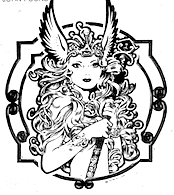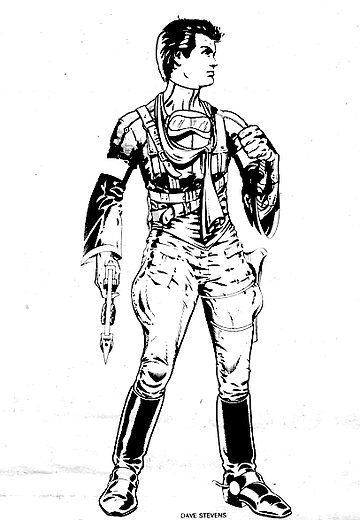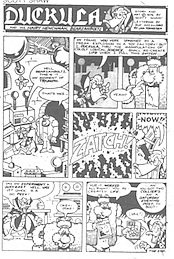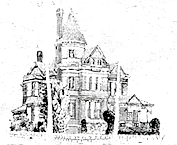 Facebook
Facebook
 X
X
 Instagram
Instagram
 TikTok
TikTok
 Youtube
Youtube

You don’t have to take a vow of poverty to be a freelance cartoonist/illustrator in San Diego, but it certainly helps. Whether California native or out-of-state emigre,' every artist who tries to crack the local market comes up against the same obstacle: Those who are inclined toward graphic art (art made for reproduction), as opposed to “fine” or gallery-type art, and at the same time don’t wish to work for or through an agency, grinding out the slick, hard-edged abstractions that pass for advertising these days (in other words, those who still feel the need to express themselves), will generally find their options in San Diego rather limited. The artist who wants to do quality work and remain independent is compelled to either seek work in larger markets out-of-city and out-of-state (which means doing business by mail and phone), or else “hustle and scrounge” for enough small jobs here at home to add up to a livable income.

Most of the artists noted in this anything-but-comprehensive survey necessarily work on the fringe, in the vaguely defined area between “street” art and “commercial” art, and each is presently coping with the difficulties cited above. Many of them see their situation in Southern California as somewhat paradoxical. “San Diego is a very inspiring place to live—perhaps too inspiring,” says Greg Lloyd, who has been active in the freelance field here for about six years. He notes that the transient culture creates a fertile field for experimentation of all kinds: some new business is always springing up with work for a graphic artist, and then disappearing just as quickly. The trouble is that San Diego’s generally relaxed lifestyle fosters a corresponding attitude of being rather than doing. “You feel less pressure here than in L.A. or other cities,” Lloyd concludes. “Your inspiration turns inward.” Lloyd has worked for various agencies in town and now seeks jobs on his own. His sketchy pen-and-ink style has been applied to all kinds of commercial projects and several striking drawings in the surreal/psychedelic vein.

This lack of pressure and urgency can certainly be cited as one of the qualitative influences on Southern California cartooning and graphic art. Other generalities can be drawn when one compares the work in this area with that in the East and the Midwest. Since WWII, the emergent “East Coast” style has tended toward a simplified, even primitive, form and a more cerebral content, as typified by the work of Jules Feiffer and several underground cartoonists on publications like the Harvard Lampoon. The New Yorker always was, and still remains, a great testing ground for artists, such as Saul Steinberg and William Steig, to whom the idea is more important than the rendering. But the California state of mind is less questioning and more accepting; and for the most part. West Coast cartoonists and illustrators have a more open and sensual response to their environment. Constantly affected by the closeness of nature and the everyday proximity of the mystical and the prosaic, established artists like Rick Griffin and Terry Lamb, both San Diego County residents, have developed surreal styles which concentrate on form and surface detail, along with outrageousness of content.

Typical of this trend is John Pound, a native San Diegan who has produced artwork for everything from comic books and T-shirts to slide shows for the county school system. Equally adept with pen or brush, cartooning or straight illustration. Pound enjoys San Diego (“It’s where I’d come to retire, so why not live here now?”) and finds it a challenge to search out local business. His fertile imagination runs to otherworldly and mythological subjects, and, having drawn strips for his high school and college papers, his major ambition, at first, lay in the comic book field. But now that he’s moved on to other things, he shares the view with many artists that comics are a rather unrewarding area of endeavor, catering to a limited mentality and offering, traditionally, payment unequal to the time and effort involved.
Dave Stevens, a National City resident, still does business with comic book publishers and consequently divides much of his time between here and Los Angeles. He has done inking for Marvel and Tarzan comics, and his deep-contrast, illustrative ink style has been applied to film posters and T-shirt designs.
In the area of pure cartooning, Scott Shaw’s loose, broad style is immediately recognizable to many San Diegans. Another lifelong resident of the area, his local career has included ads for comic book stores, posters for the Ken and Strand theatres, countless cartoons for magazines and newspapers, in‘ addition to artwork and story ideas for comic books published out of the city. He stays incredibly busy (“I’d rather go crazy from too much work than too little”) but still feels that he must supplement his income with a “steady” job in an entirely different field. “Selling yourself is difficult when there are so few opportunities around,” he says, adding that much of the time, an artist must create his own projects. This is called “working on spec”: preparing and sometimes completing a project on one’s own time without any expectation of payment—an occasional necessity when starting out, but to be avoided when at all possible. Most prosperous artists would as soon die as touch pen to paper without some prior agreement as to payment, while those new to the field, who have little to lose and can still find enjoyment in the process of drawing, are generally more eager to take chances.
And taking chances is what it’s all about, agrees Jim Cornelius, Pacific Beach native whose bizarre cartoons have accompanied the Reader's Matthew Alice columns since the paper's beginning. In addition, he operates a thriving business out of his home, doing cartoons and graphic projects for dozens of local businesses. Engaged in selling artwork since his teens, Cornelius has experimented in many forms of visual expression, including a year-and-a-half of drawing “adult” cartoons for joke magazines. Now, most of his work is local, and he is such a fixture in the P.B. area that he often finds it easier to barter services for services with his fellow merchants.
As one who has engaged for many years in the “gamble” of freelance art, Cornelius can expound at length upon the inevitable disasters that befall beginner and veteran alike, but mostly beginner. Artists who remain in the lower income brackets run the greater risk of attracting unreliable clientele. Butch Cornelius (no relation to Jim) can also recount story after story: “There are people who want quick work and expect to pay almost nothing, and people who say they’ve changed their minds after a job is completed, and people who just plain don’t know what they’re doing.” He and Louise Rendich are both part of a loose association of designers and artists operating out of a single building in Pacific Beach. He began as a cartoonist but soon branched out into sign and mural painting, T-shirt and logo design, and silkscreening (“because I was hungry”). She, originally from the East Coast, has spent the past four years pursuing graphics jobs of all kinds, while using her spare time for delicate, distinctive animal drawings. They report that their business is booming, though the bulk of their work is for commercial jobs that are relatively unexciting in any creative sense.
One artist who has managed to tread the fuzzy borderline between “fine” and “commercial" art is Mark-Elliott Lugo. In the past few years, he has established an impressive reputation in the area with a series of intricate ink renderings of Victorian houses, many of which have been reproduced in local publications. He also produces logos and ads, and has recently gained attention for his photorealist paintings, one of which currently hangs in the city’s Fine Arts Museum. A member of the museum’s Art Guild, his current success in painting has tended to overshadow his equally perfectionist graphic work. None of this work precludes a “regular” job with the San Diego Public Library for that one trace of insecurity in an unstable profession.
Many artists prefer not to handle a large flow of business, but prefer the relative freedom of the lower income brackets. Rick Geary, another whose work is seen frequently on the pages of the Reader, is a recent immigrant to San Diego from the Midwest, and presently makes a living from small jobs like flyers, book illustrations, ads, and an occasional menu or catalogue. He sells caricatures and ink drawings done in a style somewhere between illustration and cartooning. This year is his first attempt at freelancing, having worked the past four years for newspapers in Kansas. Geary has an aversion to business and finance, bordering on paranoia; and he feels that, at present, his profession is “murky and uncertain . . . though that’s to be expected.”
Yet another artist whose work appears in the Reader, Jeff Yeomans, also claims to be repelled by the business world. His specialty is supergraphics, and his huge signs and paintings adorn several San Diego buildings (like the Unicorn Trading Co., on India Street). But there are only so many structures that demand such decoration, and Yeomans has lately channeled his talents toward fine pen-and-ink drawings and whatever commercial jobs come his way.
Eric Robinson, currently a dentistry student at UCSD, has supported himself for the past five years with cartooning and graphic work. He is one of the many artists keeping alive the tradition of “surfer art” that flourishes in the beach areas, with its characteristic clean lines and rhythmic stylization of waves and bodies in space. He has also painted murals on walls and surfboards, and is at the moment working on several airbrush illustrations for a medical textbook. Cartooning, though, is his first love: “It has to come out.”
A recent survey has indicated that there are presently about 1,000 people in the San Diego area who call themselves artists, and- it seems fair to assume that most of them are unknown and struggling for success. Cartoonists and illustrators find themselves in an especially undesirable position, for there exists no local publication or vehicle to regularly convey their work to the public. No artwork is truly complete until it reaches its audience. And in San Diego the gap between product and public just seems to be a little wider than it should be.


You don’t have to take a vow of poverty to be a freelance cartoonist/illustrator in San Diego, but it certainly helps. Whether California native or out-of-state emigre,' every artist who tries to crack the local market comes up against the same obstacle: Those who are inclined toward graphic art (art made for reproduction), as opposed to “fine” or gallery-type art, and at the same time don’t wish to work for or through an agency, grinding out the slick, hard-edged abstractions that pass for advertising these days (in other words, those who still feel the need to express themselves), will generally find their options in San Diego rather limited. The artist who wants to do quality work and remain independent is compelled to either seek work in larger markets out-of-city and out-of-state (which means doing business by mail and phone), or else “hustle and scrounge” for enough small jobs here at home to add up to a livable income.

Most of the artists noted in this anything-but-comprehensive survey necessarily work on the fringe, in the vaguely defined area between “street” art and “commercial” art, and each is presently coping with the difficulties cited above. Many of them see their situation in Southern California as somewhat paradoxical. “San Diego is a very inspiring place to live—perhaps too inspiring,” says Greg Lloyd, who has been active in the freelance field here for about six years. He notes that the transient culture creates a fertile field for experimentation of all kinds: some new business is always springing up with work for a graphic artist, and then disappearing just as quickly. The trouble is that San Diego’s generally relaxed lifestyle fosters a corresponding attitude of being rather than doing. “You feel less pressure here than in L.A. or other cities,” Lloyd concludes. “Your inspiration turns inward.” Lloyd has worked for various agencies in town and now seeks jobs on his own. His sketchy pen-and-ink style has been applied to all kinds of commercial projects and several striking drawings in the surreal/psychedelic vein.

This lack of pressure and urgency can certainly be cited as one of the qualitative influences on Southern California cartooning and graphic art. Other generalities can be drawn when one compares the work in this area with that in the East and the Midwest. Since WWII, the emergent “East Coast” style has tended toward a simplified, even primitive, form and a more cerebral content, as typified by the work of Jules Feiffer and several underground cartoonists on publications like the Harvard Lampoon. The New Yorker always was, and still remains, a great testing ground for artists, such as Saul Steinberg and William Steig, to whom the idea is more important than the rendering. But the California state of mind is less questioning and more accepting; and for the most part. West Coast cartoonists and illustrators have a more open and sensual response to their environment. Constantly affected by the closeness of nature and the everyday proximity of the mystical and the prosaic, established artists like Rick Griffin and Terry Lamb, both San Diego County residents, have developed surreal styles which concentrate on form and surface detail, along with outrageousness of content.

Typical of this trend is John Pound, a native San Diegan who has produced artwork for everything from comic books and T-shirts to slide shows for the county school system. Equally adept with pen or brush, cartooning or straight illustration. Pound enjoys San Diego (“It’s where I’d come to retire, so why not live here now?”) and finds it a challenge to search out local business. His fertile imagination runs to otherworldly and mythological subjects, and, having drawn strips for his high school and college papers, his major ambition, at first, lay in the comic book field. But now that he’s moved on to other things, he shares the view with many artists that comics are a rather unrewarding area of endeavor, catering to a limited mentality and offering, traditionally, payment unequal to the time and effort involved.
Dave Stevens, a National City resident, still does business with comic book publishers and consequently divides much of his time between here and Los Angeles. He has done inking for Marvel and Tarzan comics, and his deep-contrast, illustrative ink style has been applied to film posters and T-shirt designs.
In the area of pure cartooning, Scott Shaw’s loose, broad style is immediately recognizable to many San Diegans. Another lifelong resident of the area, his local career has included ads for comic book stores, posters for the Ken and Strand theatres, countless cartoons for magazines and newspapers, in‘ addition to artwork and story ideas for comic books published out of the city. He stays incredibly busy (“I’d rather go crazy from too much work than too little”) but still feels that he must supplement his income with a “steady” job in an entirely different field. “Selling yourself is difficult when there are so few opportunities around,” he says, adding that much of the time, an artist must create his own projects. This is called “working on spec”: preparing and sometimes completing a project on one’s own time without any expectation of payment—an occasional necessity when starting out, but to be avoided when at all possible. Most prosperous artists would as soon die as touch pen to paper without some prior agreement as to payment, while those new to the field, who have little to lose and can still find enjoyment in the process of drawing, are generally more eager to take chances.
And taking chances is what it’s all about, agrees Jim Cornelius, Pacific Beach native whose bizarre cartoons have accompanied the Reader's Matthew Alice columns since the paper's beginning. In addition, he operates a thriving business out of his home, doing cartoons and graphic projects for dozens of local businesses. Engaged in selling artwork since his teens, Cornelius has experimented in many forms of visual expression, including a year-and-a-half of drawing “adult” cartoons for joke magazines. Now, most of his work is local, and he is such a fixture in the P.B. area that he often finds it easier to barter services for services with his fellow merchants.
As one who has engaged for many years in the “gamble” of freelance art, Cornelius can expound at length upon the inevitable disasters that befall beginner and veteran alike, but mostly beginner. Artists who remain in the lower income brackets run the greater risk of attracting unreliable clientele. Butch Cornelius (no relation to Jim) can also recount story after story: “There are people who want quick work and expect to pay almost nothing, and people who say they’ve changed their minds after a job is completed, and people who just plain don’t know what they’re doing.” He and Louise Rendich are both part of a loose association of designers and artists operating out of a single building in Pacific Beach. He began as a cartoonist but soon branched out into sign and mural painting, T-shirt and logo design, and silkscreening (“because I was hungry”). She, originally from the East Coast, has spent the past four years pursuing graphics jobs of all kinds, while using her spare time for delicate, distinctive animal drawings. They report that their business is booming, though the bulk of their work is for commercial jobs that are relatively unexciting in any creative sense.
One artist who has managed to tread the fuzzy borderline between “fine” and “commercial" art is Mark-Elliott Lugo. In the past few years, he has established an impressive reputation in the area with a series of intricate ink renderings of Victorian houses, many of which have been reproduced in local publications. He also produces logos and ads, and has recently gained attention for his photorealist paintings, one of which currently hangs in the city’s Fine Arts Museum. A member of the museum’s Art Guild, his current success in painting has tended to overshadow his equally perfectionist graphic work. None of this work precludes a “regular” job with the San Diego Public Library for that one trace of insecurity in an unstable profession.
Many artists prefer not to handle a large flow of business, but prefer the relative freedom of the lower income brackets. Rick Geary, another whose work is seen frequently on the pages of the Reader, is a recent immigrant to San Diego from the Midwest, and presently makes a living from small jobs like flyers, book illustrations, ads, and an occasional menu or catalogue. He sells caricatures and ink drawings done in a style somewhere between illustration and cartooning. This year is his first attempt at freelancing, having worked the past four years for newspapers in Kansas. Geary has an aversion to business and finance, bordering on paranoia; and he feels that, at present, his profession is “murky and uncertain . . . though that’s to be expected.”
Yet another artist whose work appears in the Reader, Jeff Yeomans, also claims to be repelled by the business world. His specialty is supergraphics, and his huge signs and paintings adorn several San Diego buildings (like the Unicorn Trading Co., on India Street). But there are only so many structures that demand such decoration, and Yeomans has lately channeled his talents toward fine pen-and-ink drawings and whatever commercial jobs come his way.
Eric Robinson, currently a dentistry student at UCSD, has supported himself for the past five years with cartooning and graphic work. He is one of the many artists keeping alive the tradition of “surfer art” that flourishes in the beach areas, with its characteristic clean lines and rhythmic stylization of waves and bodies in space. He has also painted murals on walls and surfboards, and is at the moment working on several airbrush illustrations for a medical textbook. Cartooning, though, is his first love: “It has to come out.”
A recent survey has indicated that there are presently about 1,000 people in the San Diego area who call themselves artists, and- it seems fair to assume that most of them are unknown and struggling for success. Cartoonists and illustrators find themselves in an especially undesirable position, for there exists no local publication or vehicle to regularly convey their work to the public. No artwork is truly complete until it reaches its audience. And in San Diego the gap between product and public just seems to be a little wider than it should be.
Comments